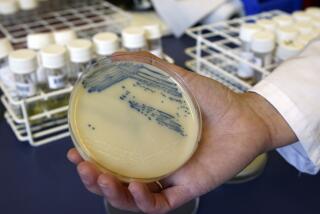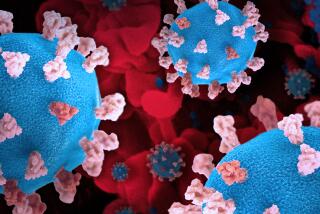Shape May Help Drugs Fight AIDS : Health: A computer identifies the outlines of existing chemicals. It then seeks a ‘fit’ that would lock into and disable the HIV virus.
WASHINGTON — Scientists at the University of California at San Francisco, departing from the traditional methods of searching for new drugs, have developed a new computerized technique for identifying compounds that could treat AIDS or other disorders, federal health officials announced Friday.
Using the procedure, the scientists already have determined that a common antipsychotic drug can stop the human immunodeficiency virus from multiplying in a test tube, although only at lethal dosage levels.
Health and Human Services Secretary Louis W. Sullivan called the work “a major step forward in the application of basic research to disease-targeted strategies.” Dr. James O. Mason, assistant secretary for health, said the new approach “emphasizes molecular shape over chemistry” and is “a highly promising method to search for new drugs.”
Typically, the quest for new drugs involves random testing of thousands of chemicals. But Irwin D. Kuntz Jr., a professor of pharmaceutical chemistry at UC San Francisco, used a computer to first define the shape of a critical enzyme known as a protease in the HIV virus, which causes AIDS.
Then he and his colleagues used a computer program called DOCK to track down potential chemicals whose molecular structure would fit into the grooves of the protease, much as a key fits into a lock, or, as Kuntz put it, “a plug into a bathtub.”
“We were looking at the shapes of molecules,” Kuntz said in an interview. “That is something that people have tried to do in their heads for generations, but it’s quite complicated. The computer is a hero at manipulating all the distances in a shape. The computer can keep all those images in its memory very easily.”
Although the researchers currently are directing their efforts toward finding drugs to combat AIDS, Kuntz said the technique ultimately could be used to look for drugs to treat other conditions. “Good candidates might be influenza or the common cold,” he said.
Kuntz, who presented his work Friday at a meeting at the National Institutes of Health, said he and his colleagues aimed their research at finding a drug that would fit into the structure of the HIV protease.
According to UC San Francisco, the protease functions as a “molecular scissors that snips out the proteins that make up a new virus, analogous to cutting out the material for a new dress.” When the enzyme is blocked, the virus becomes inactive and cannot multiply.
The researchers searched a bank of 60,000 known chemicals, looking for a substance with a complementary shape that could fit snugly into the HIV enzyme’s machinery, thus crippling it.
In its current form, Kuntz said, the computer program can only search for a suitable “template” that chemists will have to modify to make more effective, much like “etching grooves in the blank key so that it fits precisely into the lock.”
After narrowing the list of chemicals, the researchers eventually found that haloperidol, a common antipsychotic drug sold under the name Haldol, was a close fit--and, in fact, stopped the AIDS virus from replicating in the test tube. However, the drug is effective against HIV only in doses that would be lethal for humans.
“No one should take it,” Kuntz said. “It just can’t help at all. If they took it at the levels indicated by the test-tube experiments, they would die.”
Kuntz said the work with haloperidol is only “a beginning” and that efforts were now under way to change the structure of the drug in ways that would preserve its desired activity against the AIDS virus while decreasing its toxicity.
AIDS researchers called the approach “promising” but were cautious about its practical application.
“I think they would have to model the various compounds to be sure they don’t fit similar enzymes we have in the body, so that the drugs don’t create side effects,” said Dr. David Ho, director of the AIDS virology lab at the UCLA School of Medicine.
Dr. Robert T. Schooley, an AIDS researcher at Harvard University, said that “related approaches in the past have suffered because the precision hasn’t been high enough to make the drugs fit well enough in practice. But this sounds like they have a more powerful computerized approach.”
Schooley said that the major emphasis of the National Institutes of Health’s AIDS drug discovery program has been to “try to make educated guesses about what might work, rather than shuffling through thousands and thousands of mushroom extracts. This approach seems to be consistent with that goal.”
The UC San Francisco scientists, whose work was funded by the National Institute of General Medical Sciences, said that an “exciting” aspect of their research was that, unlike most compounds found to date that cripple the HIV protease, haloperidol is not a peptide. Peptide-based drugs are broken down in the digestive tract and are difficult to deliver orally, Kuntz said.
Also, he said, haloperidol can cross the blood-brain barrier--a complex body system that prevents most chemicals from entering the brain. That attribute is essential for any effective AIDS treatment, because HIV almost always invades the brain.
The discovery of haloperidol’s anti-HIV activity came as a surprise because it would not have been predicted by the drug’s chemistry alone, he said.
Even if the experiments with haloperidol do not produce a satisfactory drug against AIDS, the new approach to drug design could yield additional compounds with which to treat AIDS and other disorders, Kuntz said.






